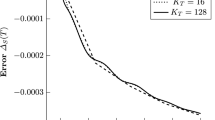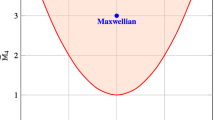Abstract
Uniqueness of solutions to the SPH integral formulation of the hydrostatic problem, and the convergence of such solution to the exact linear pressure field, are theoretically demonstrated in this paper using Fourier analytical techniques. This problem involves the truncation of the kernel when the Dirichlet boundary condition (BC) on the pressure is imposed at the free surface. Certain hypotheses are assumed, the most important being that the variations of the pressure field occur in length scales of the order of the smoothing length, h. The theoretical analysis is complemented with numerical tests. In addition to the BC at the free surface, the numerical solution requires truncating the infinite subdomain below it, imposing a Neumann BC for the pressure. The consistency and convergence of the numerical solution of the truncated equation with these BCs are sought herein with a global approach, as opposed to previous studies which exclusively assessed it based on the class of the flow extensions. In these numerical tests, and consistently with the theoretical results, the convergence to the exact solution is shown numerically for discretizations with an inter-particle distance to h ratio of order one. However, when this ratio goes to zero as h also goes to zero, it is shown that length scales shorter than h appear in the solution, and that convergence is lost. The conclusions are important for SPH practitioners as setting that ratio to be of order one is a standard practice to lower the computational time.








Similar content being viewed by others
Notes
Note that \(g^+_h(x)\) is zero for every \(x < 0\) and, at the same time, \(\overline{u_h^-}(x)\) is zero for all \(x \ge 0\). So that, their product is identically zero and so is the integral
$$\begin{aligned} \displaystyle \int _{-\infty }^{\infty } g^+_h(x) \overline{u^-_h}(x) \mathrm{d}x = 0, \end{aligned}$$which represents the \(L^2\) inner product.
To check this formula simply note that:
$$\begin{aligned} p^-(x)=&\frac{x-|x|}{2}\implies \widehat{p^-}(\xi )=i\pi \delta '(\xi )+\frac{1}{\xi ^2},\quad \text {and}\quad \\&(\widehat{W_h}\widehat{p^-})(\xi )=i\pi \widehat{W_h}(0)\delta '(\xi )-i\pi \widehat{W_h}'(0)\delta (\xi )+\frac{\widehat{W_h}(\xi )}{\xi ^2}. \end{aligned}$$While convergence in the error E is not attained in the cases of Wendland Kernels \(C^4\) and \(C^6\), it has been numerically checked that the interpolated value of the pressure at zero, \(\left\langle p_h \right\rangle (0)\), does converge to its exact value, zero, for the three kernels tested. The numerical solution’s interpolated derivative also returns its exact value, \(-1\).
This explains the introduction of the notation \(g^+_h\), as opposed to \(f^-_h\), which is zero for \(x \in (0, +\infty )\).
References
Antuono M, Colagrossi A, Marrone S (2012) Numerical diffusive terms in weakly-compressible SPH schemes. Comput Phys Commun 183(12):2570–2580. https://doi.org/10.1016/j.cpc.2012.07.006
Antuono M, Colagrossi A, Marrone S, Molteni D (2010) Free-surface flows solved by means of SPH schemes with numerical diffusive terms. Comput Phys Commun 181(3):532–549. https://doi.org/10.1016/j.cpc.2009.11.002
Bouscasse B, Colagrossi A, Marrone S, Antuono M (2013) Nonlinear water wave interaction with floating bodies in SPH. J Fluids Struct 42:112–129
Bouscasse B, Colagrossi A, Marrone S, Souto-Iglesias A (2017) SPH modelling of viscous flow past a circular cylinder interacting with a free surface. Comput Fluids 146:190–212. https://doi.org/10.1016/j.compfluid.2017.01.011
Calderon-Sanchez J, Cercos-Pita J, Duque D (2019) A geometric formulation of the Shepard renormalization factor. Comput Fluids 183:16–27. https://doi.org/10.1016/j.compfluid.2019.02.020
Colagrossi A, Antuono M, Le Touzé D (2009) Theoretical considerations on the free-surface role in the smoothed-particle-hydrodynamics model. Phys Rev E 79(5):056701. https://doi.org/10.1103/PhysRevE.79.056701
Colagrossi A, Antuono M, Souto-Iglesias A, Le Touzé D (2011) Theoretical analysis and numerical verification of the consistency of viscous smoothed-particle-hydrodynamics formulations in simulating free-surface flows. Phys Rev E 84:026,705
Dehnen W, Aly H (2012) Improving convergence in smoothed particle hydrodynamics simulations without pairing instability. Mon Not R Astron Soc 425(2):1068–1082. https://doi.org/10.1111/j.1365-2966.2012.21439.x
Di Lisio R, Grenier E, Pulvirenti M (1998) The convergence of the SPH method. Comput Math Appl 35(1–2):95–102
Du Q, Lehoucq R, Tartakovsky A (2015) Integral approximations to classical diffusion and smoothed particle hydrodynamics. Comput Methods Appl Mech Eng 286:216–229. https://doi.org/10.1016/j.cma.2014.12.019
Dyka C, Ingel R (1995) An approach for tension instability in smoothed particle hydrodynamics (SPH). Comput Struct 57(4):573–580
Evers JH, Zisis IA, van der Linden BJ, Duong MH (2018) From continuous mechanics to SPH particle systems and back: systematic derivation and convergence. ZAMM 98(1):106–133
Fernandez-Gutierrez D, Souto-Iglesias A, Zohdi TI (2018) A hybrid Lagrangian Voronoi SPH scheme. Comput Part Mech 5:345–354. https://doi.org/10.1007/s40571-017-0173-4
Ferrand M, Laurence DR, Rogers BD, Violeau D, Kassiotis C (2013) Unified semi-analytical wall boundary conditions for inviscid, laminar or turbulent flows in the meshless SPH method. Int J Numer Meth Fluids 71(4):446–472. https://doi.org/10.1002/fld.3666
Franz T, Wendland H (2018) Convergence of the smoothed particle hydrodynamics method for a specific barotropic fluid flow: constructive kernel theory. SIAM J Math Anal 50(5):4752–4784. https://doi.org/10.1137/17M1157696
Gingold R, Monaghan J (1977) Smoothed particle hydrodynamics: theory and application to non-spherical stars. MNRAS 181:375–389
Gray J (2001) Caldera collapse and the generation of waves. Ph.D. thesis, Monash University
Imoto Y (2019) Unique solvability and stability analysis for incompressible smoothed particle hydrodynamics method. Comput Part Mech 6(2):297–309
Kawahara M, Umetsu T (1986) Finite element method for moving boundary problems in river flow. Int J Numer Methods Fluids 6(6):365–386. https://doi.org/10.1002/fld.1650060605
Kesserwani G, Liang Q (2012) Dynamically adaptive grid based discontinuous Galerkin shallow water model. Adv Water Resour 37:23–39. https://doi.org/10.1016/j.advwatres.2011.11.006
Lind SJ, Stansby P (2016) High-order eulerian incompressible smoothed particle hydrodynamics with transition to Lagrangian free-surface motion. J Comput Phys 326:290–311
Lisio RD (1995) A particle method for a self gravitating fluid. Math Methods Appl Sci 18:1083–1094. https://doi.org/10.1002/mma.1670181305
Macià F, Antuono M, González LM, Colagrossi A (2011) Theoretical analysis of the no-slip boundary condition enforcement in SPH methods. Prog Theor Phys 125(6):1091–1121. https://doi.org/10.1143/PTP.125.1091
Marrone S, Antuono M, Colagrossi A, Colicchio G, Le Touzé D, Graziani G (2011) \(\delta \)-SPH model for simulating violent impact flows. Comput Methods Appl Mech Eng 200(13–16):1526–1542. https://doi.org/10.1016/j.cma.2010.12.016
Mayrhofer A, Rogers BD, Violeau D, Ferrand M (2013) Investigation of wall bounded flows using SPH and the unified semi-analytical wall boundary conditions. Comput Phys Commun 184(11):2515–2527. https://doi.org/10.1016/j.cpc.2013.07.004. arXiv:1304.3692
Michel-Dansac V, Berthon C, Clain S, Foucher F (2016) A well-balanced scheme for the shallow-water equations with topography. Comput Math Appl 72(3):568–593. https://doi.org/10.1016/j.camwa.2016.05.015
Monaghan J (2000) SPH without a tensile instability. J Comput Phys 159(2):290–311
Morris J (1996) A study of the stability properties of SPH. Publ Astron Soc Aust 13:97–102 arXiv:astro-ph/9503124
Quinlan NJ, Lastiwka M, Basa M (2006) Truncation error in mesh-free particle methods. Int J Numer Methods Eng 66(13):2064–2085. https://doi.org/10.1002/nme.1617
Ricchiuto M (2011) On the c-property and the generalized c-poperty of residual distribution for the shallow water equations. J Sci Comput 48:304–318. https://doi.org/10.1007/s10915-010-9369-y
Valizadeh A, Monaghan JJ (2015) A study of solid wall models for weakly compressible SPH. J Comput Phys 300:5–19. https://doi.org/10.1016/j.jcp.2015.07.033
Vila J (1999) On particle weighted methods and smooth particle hydrodynamics. Math Models Methods Appl Sci 9(2):161–209
Violeau D (2009) Dissipative forces for Lagrangian models in computational fluid dynamics and application to smoothed-particle hydrodynamics. Phys Rev E 80:036,705. https://doi.org/10.1103/PhysRevE.80.036705
Violeau D, Rogers BD (2016) Smoothed particle hydrodynamics (SPH) for free-surface flows: past, present and future. J Hydraul Res 54(1):1–26. https://doi.org/10.1080/00221686.2015.1119209
Wendland H (1995) Piecewise polynomial, positive definite and compactly supported radial functions of minimal degree. Adv Comput Math 4(4):389–396. https://doi.org/10.1007/BF02123482
Funding
This study was partially funded by the Spanish Ministry of Innovation and Universities (MCIU) through Grants MTM2017-85934-C3-3-P and RTI2018-096791-B-C21 “Hidrodinámica de elementos de amortiguamiento del movimiento de aerogeneradores flotantes”. P.E. Merino is supported during the completion of his Ph.D. thesis by MEyFP Grant FPU17/05433 and thanks MEyFP for its support.
Author information
Authors and Affiliations
Corresponding author
Ethics declarations
Conflict of interest
The authors declare that they have no conflict of interest
Additional information
Publisher's Note
Springer Nature remains neutral with regard to jurisdictional claims in published maps and institutional affiliations.
Appendices
Transforming an integral equation into a (full) convolution equation
In this appendix, a generalization of the processes followed in Sects. 5 and 6 to obtain full convolution equations [(23) and (27)] from their preceding truncated integral equations [(1) and (15), respectively,] is provided. Note that a convolution equation is of the form (28). This is not the case of Eqs. (1) and (15), which are instead of the form
where \(f_h(z)\) and g(z) are functions defined only for \(z < 0\).
The process consists of two main steps:
-
1.
In the first step, the integral is extended to the whole real line by introducing the extended function
$$\begin{aligned} f_h^-(z) := {\left\{ \begin{array}{ll} f_h(z), &{}z < 0, \\ 0, &{}z \ge 0. \end{array}\right. } \end{aligned}$$(42)Applying this extension to (41) leads to an integral in which the limits of integration have been extended to the whole space \({\mathbb {R}}\):
$$\begin{aligned} \displaystyle \int _{-\infty }^{\infty } W_h(x-y) f^-_h(y) \mathrm{d}y = g(x), \quad x \in (-\infty ,0). \end{aligned}$$(43) -
2.
In a second step, a full convolution equation is obtained by requiring that (43) holds for every value of x in the whole real line. The left-hand side term becomes then \((W_h *f^-_h)(x)\). This convolution may take values different from zero for some \(x > 0\). To take this into account, an extra unknown, \(g^+_h(x)\), has to be introduced in the right-hand side. This new function has to be identically zero for \(x \in (-\infty , 0)\)Footnote 4 so the equation is unchanged in the region \(x<0\). The function g(x) is extended by zero for \(x > 0\). All these considerations finally lead to
$$\begin{aligned} \displaystyle \int _{-\infty }^{\infty } W_h(x-y) f^-_h(y) \mathrm{d}y = g^-(x) + g^+_h(x), \quad x \in {\mathbb {R}}. \end{aligned}$$(44)
Deduction of a full convolution equation for the error \(e_h\)
Let us now particularize the process described in A to deduce Eq. (27). Consider Eq. (15):
-
In the first step, the function \(p_h(y)\) is extended by zero to \({\mathbb {R}}\), getting
$$\begin{aligned} \displaystyle \int _{-\infty }^{\infty } W_h(x-y) p^-_h(y) \mathrm{d}y = p(x), \quad x \in (-\infty ,0), \end{aligned}$$(45)with p(x) the exact solution, \(p(x) = -x\), defined for \(x \in (-\infty ,0)\).
-
To extend the previous equation to the whole real line, the new unknown \(g^+_h(x)\) is introduced, leading to
$$\begin{aligned} (W_h *p^-_h )(x) = p^-(x) + g^+_h(x), \quad x \in {\mathbb {R}}. \end{aligned}$$(46)Finally, substituting \(p_h^-(y)\) by \(p^-(y) + e^-_h(y)\) in (46) and rearranging the resulting different terms one recovers equation (23):
$$\begin{aligned} (W_h *e^-_h )(x) = p^-(x) - (W_h *p^-)(x) + g^+_h(x), \quad x \in {\mathbb {R}}. \end{aligned}$$(47)
Rights and permissions
About this article
Cite this article
Macià, F., Merino-Alonso, P.E. & Souto-Iglesias, A. On the truncated integral SPH solution of the hydrostatic problem. Comp. Part. Mech. 8, 325–336 (2021). https://doi.org/10.1007/s40571-020-00333-6
Received:
Revised:
Accepted:
Published:
Issue Date:
DOI: https://doi.org/10.1007/s40571-020-00333-6




